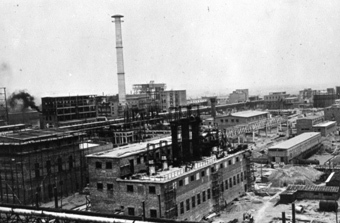Buna for the Wartime Economy – Planing and Large-Scale Production in the Years 1933–1945

© Fritz Bauer Institute (Zahn papers)
Following the transfer of power to the National Socialists, the Reichswehr (German armed forces, 1919–1935) and I.G. Farben resumed negotations concerning the production of Buna rubber in May 1933. In November 1933, these talks resulted in the decision to lend state support, in the course of the Nazi regime’s military buildup, to the producing of Buna because of its military significance for motorized warfare. After the naming of Hermann Göring as Commissioner for Raw Materials and Foreign Exchange and with the decisive participation of Carl Krauch, a member of the supervisory board of I.G. Farben, the Four Year Plan was worked out in 1936, defining the goals of the Nazi regime’s arms buildup in the area of strategic raw materials. Under the Four Year Plan, production capacity first was set in October 1936 at 72,000 tons of Buna per annum, to be manufactured on an illusory timetable in three new plants that were to be built, starting in early 1939.[1] Shortly thereafter, estimated requirements were revised upward to 100,000 tons of Buna each year, a goal to be achieved in four plants, each with a capacity of 25,000 tons annually.[2]
Construction of I.G. Farben’s first Buna plant was begun in Schkopau in 1936. Work on building the second Buna factory for I.G. Farben, in Hüls, started in May 1938. Shortfalls of building materials and a substantial shortage of manpower at the construction sites of the Buna plants in May and June 1938 led to a shelving of the plan to build the third Buna plant at first. The development of a fourth Buna plant had been addressed in the Four Year Plan in mid-1937, but in the end it was “not further pursued, however.”[3] After lengthy negotiations between the armaments authorities of the Nazi state and I.G. Farben concerning expansion of Buna production, the Reich Office for Economic Expansion (Reichsamt für Wirtschaftsausbau) in November 1938 approved a hike in the Buna capacities, upon completion, from an annual level of 40,000 tons to 60,000 in Schkopau and from 30,000 tons to 40,000 in Hüls.[4] As these two plants thus would attain the targeted production capacity of 100,000 tons of Buna in total, the final choice of sites for the planned Buna III and Buna IV factories could be deferred a bit longer.
Immediately before the invasion of Poland, German’s rubber supply still was based almost entirely on imports from the global market. In the literature, estimates of Germany’s dependence on imports from foreign rubber production for the year 1939 range between 80 and 90 percent.[5] After the Wehrmacht’s military victories in Poland and Western Europe, the planned targets for Buna production were further increased in light of the altered geopolitical circumstances, in expectation of new sales markets in the context of a European Großraumwirtschaft, a “greater economic zone” under German hegemony. In fall 1940, inside I.G. Farben, it was assumed that an economic input of Buna production at a level of 120,000 to 150,000 tons per annum was required in order to meet total requirements of 300,000 tons of rubber annually “in the Central European economic region.”[6] The production capacities actually available at the start of the war, however, were still far from the targeted figures. Before the war, manufacturing of synthetic rubber had begun only in the Buna plant in Schkopau, in 1937. Production warmed up only gradually in Hüls (Buna II), in 1940, and in Ludwigshafen (Buna III), not until late 1942.[7] The I.G. Farben plant in Auschwitz (Buna IV), under construction since April 1941, was scheduled to come onstream in 1943. Because of shortages of construction materials and manpower, however, the projected start of operations was finally postponed to February/March 1945. The inception of Buna production in Auschwitz was thwarted by the Red Army’s capture of the plant on January 27, 1945. During World War II, the share of synthetic rubber manufacture accounted for by I.G. Farben’s Buna plants increased sharply, and by the war’s end, production was capable of meeting the demand.
(FS; transl. KL)
|
Kautschukproduktion und Verbrauch in Deutschland (1939–1944) [8]
|
|||
|
Jahr |
Gesamtproduktion in 1000 t |
davon synthetische Produktion |
Anteil in Prozent |
|
1939 |
99 |
22 |
22 |
|
1940 |
57 |
40 |
70 |
|
1941 |
96 |
69 |
72 |
|
1942 |
123 |
117 |
80 |
|
1943 |
124 |
117 |
94 |
|
1944 |
104 |
104 |
100 |
















